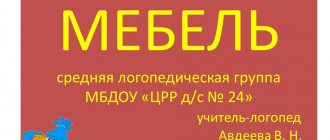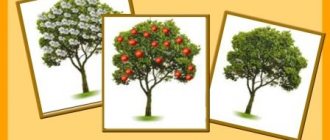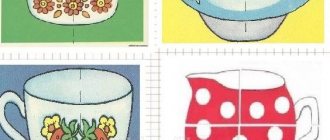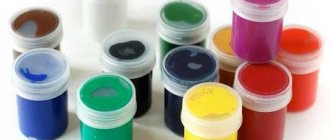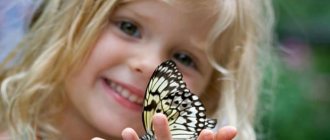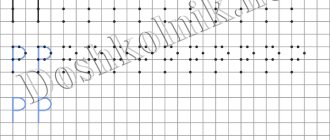MAGAZINE Preschooler.RF
Municipal preschool educational institution kindergarten "Mashenka" Lesson summary on the formation of lexical and grammatical categories Topic: TABLEWARE Developed by: Educator Lazareva N.P. Surgut Lesson on speech development and the formation of lexical and grammatical categories. Topic: Dishes. Program content: 1. Expansion and enrichment of vocabulary on the topic “Utensils”, classification of utensils by method of use. 2. Consolidation of skills in the correct use of names and purposes of utensils. 3. Exercise in forming nouns using suffixes and relative adjectives. 4. Development of coherent speech through the compilation of descriptive stories using a visual plan. 5. Developing the ability to listen to each other’s answers to the end.Vocabulary work: Kitchen utensils, tea utensils, tableware, sugar bowl, salad bowl, bread bowl, candy bowl. Equipment: Illustrations, models, ball, picture with a noisy image. Individual work: Strengthen with Nastya the ability to answer in full sentences.
Progress of the lesson: Organizational moment: - Tell me, who is this poem about? The sieve gallops through the fields, and the trough through the meadows. The broom followed the shovel along the street. (This is a poem about Fedora.) - What happened to her? (She left the dishes because she didn’t like them.) - Today we are visiting Fedora, we will help her deal with the dishes and tell her everything we know about the dishes, teach her how to use the dishes. Take one picture at a time and tell me what it is? (This is a frying pan, a kettle, etc.) - How to call it in one word, Vanya? (This is dishes.) - What kind of dishes are there? (Kitchen, dining room, tea room.) - Arrange the dishes in Fedora’s kitchen. What kind of dishes will go on the stove? (Kitchen.) - And on the table? (There will be cutlery on the table.) - What should we put in the closet? (We’ll put the teaware in the closet.) - Arrange it. Vanya, what kind of dishes are on the stove? (There is a frying pan and a kettle on the stove, because these are kitchen utensils.) - Nastya, what is on the table? (There is a tureen and a plate on the table, because these are tableware.) - Pasha, what dishes were put in the closet? (In the closet there is a sugar bowl and a teapot, because these are tea utensils.) - This is the order Fedora has now, and she brought a picture and asks to tell what is drawn on it. Glory, what do you see, and what parts does this object consist of? (I see a teapot. It has a bottom, walls, a spout, a handle, a lid with a handle.) - What do they do in a teapot? (They boil water in it.) - Vanya, what did you see? (A saucepan. It has a bottom, walls, two handles and a lid with a handle. Soup is cooked in the saucepan.) - Now Lesha will say. (I saw a frying pan. It has a bottom, walls, and a handle. Pancakes are fried in the frying pan). - Mark, tell me. (A cup is drawn here. It has a bottom, walls, and a handle. People drink tea from it). - Well, Pasha will say. (A teapot is drawn here. It has a bottom, walls, a spout, a handle, a lid with a handle. Tea is brewed in it.) - Well done, guys. Fedora has so many dishes, she is confused about what they are made of. We'll tell her about it. Get up from your chairs. I will tell you what the dishes are made of, and you will tell me what they are. Aluminum saucepan - Clay jug - Glass glass - Porcelain cup - Crystal vase - Cast iron frying pan - Wooden spoon - Gold tray - - Well done. Listen to the poem Once upon a time there were dishes: a teapot, a cup and a dish, a knife, a fork and a spoon, a saucepan and a ladle. The saucepan was friends with food, the saucepan was friends with water, and it was friends with people. She fed him deliciously. — Dishes are a home for food. And now we will tell you about this Fedor.
Game "House for dishes". Sugar lives... (in a sugar bowl) Bread lives... (in a bread bowl) Salad lives... (in a salad bowl) Butter lives... (in a butter dish) Pepper lives... (in a pepper shaker) Herring lives... (in a herring bowl) Sweets live... (in a candy bowl) Crackers live... (in a cracker)
- Well done. The next game is “Name the signs and actions.” We will teach Fedora to tell stories using models. What is this? (This is a cup.) - What cup? (tea, porcelain, clean, new) - Lesha, what do they do with this item and what is it called? (This is a saucepan. A saucepan is washed, cleaned, bought, thrown away, placed, wiped, put away, dried.) - Okay, what, Vanya, can you do in this dish? (They fry in a frying pan, fry, fry, fry.) - You have completed all the tasks, now let’s rest. Stand in a circle. Physical education break: Here is a big pot-bellied teapot, Very important, like a boss. Here are the porcelain cups, very fragile, poor things. Here are the porcelain saucers, just knock and they will break. Here are the silver spoons, the head on a thin stem. Here is a plastic tray, He brought us the dishes. - Let's remember how we made up complex words and explain to Fedora what they mean. Meat grinder - ... (chops meat) Bread slicer - ... (cuts bread) Vegetable slicer - ... (cuts vegetables) Samovar - ... (cooks it himself) Cheese slicer - ... (cuts cheese) Juicer - ... (squeezes juice) Sweet tooth - ... (eats sweets) - Now we will make proposals based on models and teach this to Fyodor. Look at the first model. Mark, make a proposal. (Masha puts the cup on the table.) - Well done, now, Pasha, try the second sentence. (Masha bought a teapot and a sugar bowl.) - How else is it possible? Lenya? (Mom brought a teapot and a sugar bowl. Mom took away the teapot and a sugar bowl.) - Nastya, make up the third sentence. (Dad put the pan on the stove.) - What did we make up? (Sentences.) - What does the sentence express? (Thought.) - What sign is at the end of the sentence? (There is a period at the end of the sentence.) - You know how to make sentences, and now we’ll make up a story, and guess what the story is about: I’m puffing, puffing, puffing, I don’t want to get warm anymore. The lid rang loudly: “Drink tea, the water has boiled.” (This is a teapot.) (A picture is displayed.) - We will write a story about it using a visual plan. Pictures with a visual plan are distributed and a descriptive story is compiled. Result: - What did we talk about today? (About dishes.) - What kind of dishes are there? (Tea room, dining room, kitchen.) - You helped Fedora clean up the kitchen and arrange the dishes correctly. For this she wants to treat you.
| Next > |
Game lesson on speech development on the topic “Dishes”
- February 20, 2013
Competition “My Pedagogical Initiative - 2012”
Nomination “Methodological work in preschool educational institutions”
In various game situations during speech therapy classes, children acquire correct speech skills. During preliminary work, children acquire sufficient experience in orientation on this topic.
Therefore, I conduct final classes in each period of speech therapy work as a festive event. It is not entertaining, but educational. This is a kind of result, a generalization of all acquired knowledge, skills and abilities. After all, the child most fully and clearly perceives and remembers what affected him most emotionally, what was interesting to him.
Unlike ordinary children's parties, where, as a rule, the most lively and capable people are occupied, all children participate here. To gain confidence in their own knowledge, children are given the opportunity to show themselves and others their awareness of a given topic.
Preparation for the final lesson takes 3–4 days. Accompanied by thematic conversations, didactic speech games, display of visual material, reading fiction: poems, fairy tales, short stories, riddles; I teach in advance how to compose descriptive stories about any piece of utensils according to a diagram.
The lesson is structured in the form of a problem situation, in the form of a “provocative” dialogue with children, which allows preschoolers to think about the properties and quality of the materials from which the dishes are made, to better understand the topic, broaden their horizons, and enrich their vocabulary.
The effectiveness of this lesson is quite high due to the fact that the basic knowledge of preschoolers on the topic “Utensils” finds its application in it. Children clearly feel the value of the skills they have accumulated and apply them in practice (in conversation, didactic games, art activities, etc.).
The presented summary traces the interdisciplinary connection of classes in “The world around us”, “Speech development”, “Mathematics”, “Art activities”, “Music”. Individual handout cards with tasks that develop logic and children's thinking are original, made specifically for this lesson and have not been used or used anywhere before.
It is recommended that the lesson be conducted in a fun, emotional, and playful manner, evoking positive emotions in children from the correct answers they give. Everything should contribute to a joyful and upbeat mood in children and their free speech communication.
Program content
Goals:
- Continue to instill interest in the life of the Russian village.
- To consolidate children's knowledge about modern and ancient dishes.
- To consolidate knowledge about different types of utensils and their purposes.
- Expand children's active and passive vocabulary.
- Formation of lexical-grammatical structure and coherent speech.
- Develop perception, attention, memory, thinking, imagination and
- emotional-volitional processes.
- Develop graphic skills.
- Cultivate a caring attitude towards dishes.
Tasks:
- activate the dictionary on the topic “Dishes”, a dictionary of synonyms, encourage them to practice word formation.
- improve the grammatical structure of speech, the ability to coordinate adjectives in gender, number, and case.
- activate mental activity, learn to solve riddles and resolve problem situations.
- consolidate the ability to write descriptive stories about dishes.
Techniques of cognitive and speech development:
- verbal technique: conversation, question - answer;
- solving a problem situation;
- didactic games: “Add the required piece of utensils to each group”, “Find the pattern”, “Count and name”, “Color the outline of the samovar”;
- visual technique.
Vocabulary work:
- Active vocabulary: cast iron, samovar, grip, iron, wood, glass, shiny, transparent.
- Passive vocabulary: painted, porcelain, plastic, clay.
Preliminary work:
- Reading the work of K. Chukovsky “Fedorino’s grief.”
- Games on the theme “Dishes”;
- Musical game “Bai-kachi-kachi-kachi”.
- Introducing children to the properties of wood, glass, iron, clay, cast iron.
- Training in writing descriptive stories about any item of utensils according to a diagram.
Equipment:
- suit for Fedora,
- samovar,
- cast iron,
- pot,
- iron and wooden spoons,
- any aesthetically made dishes,
- individual tasks (cards),
- visual aids (photos of samovars),
- outlines of samovars, paints, pencils.
Appendix 1: Speech therapy lesson notes.
Author: Tatyana Aleksandrovna Zykina, teacher-speech therapist at MBDOU No. 312 “Katyusha”, Rostov-on-Don. Work experience in the specialty is 10 years.
